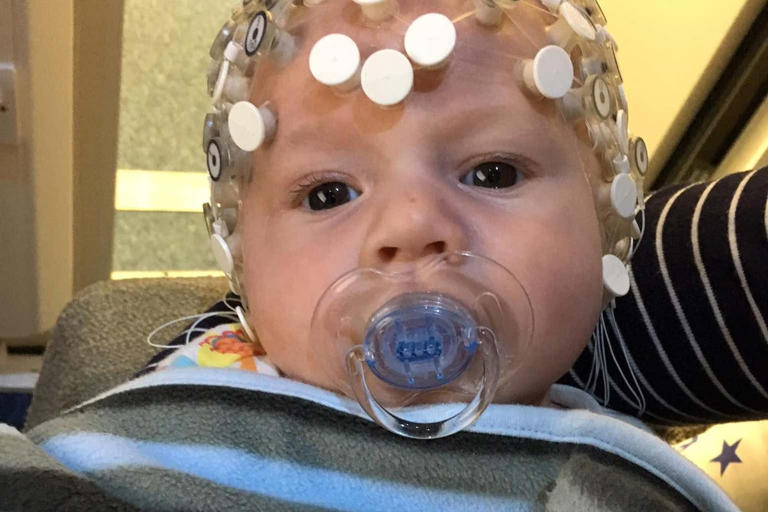






Speaking to babies in sing-song speech ‘helps them learn language’
Parents should speak to babies in sing-song speech to help them learn language, experts have said.
Scientists from the University of Cambridge have found that infants learn languages from rhythmic information – the rise and fall of tone – as seen in nursery rhymes or songs.
They also discovered that babies do not begin to process phonetic information – the smallest sounds of speech – until they are around seven months old.
The researchers said the findings, published in the journal Nature Communications, challenge the view that phonetic information – typically represented by the alphabet – is the key to language learning.
They said it also suggests that dyslexia and developmental language disorder may be associated with rhythm perception rather than difficulties with processing phonetic information.
Study author Professor Usha Goswami, a neuroscientist at the University of Cambridge, said: “Our research shows that the individual sounds of speech are not processed reliably until around seven months, even though most infants can recognise familiar words like ‘bottle’ by this point.
We believe that speech rhythm information is the hidden glue underpinning the development of a well-functioning language system
“From then individual speech sounds are still added in very slowly – too slowly to form the basis of language.
“We believe that speech rhythm information is the hidden glue underpinning the development of a well-functioning language system.
“Parents should talk and sing to their babies as much as possible or use infant-directed speech like nursery rhymes because it will make a difference to language outcome.”
It has previously been thought that infants learn small sound elements and add them together to make words.
To understand whether that was the case, the researchers recorded the brain activity of 50 infants at four, seven and 11 months old as they watched a video of a primary school teacher singing 18 nursery rhymes.
The team used special algorithms to interpret how the infants were encoding this information in the brain.
The scientists found that phonetic encoding in babies emerged gradually over the first year of life, beginning with dental sounds (produced by the upper front teeth) – such as “d” for “daddy” – and nasal sounds (produced when airflow is directed through the nose) – such as “m” for “mummy”.
rof Goswami said: “Infants can use rhythmic information like a scaffold or skeleton to add phonetic information on to.
“For example, they might learn that the rhythm pattern of English words is typically strong-weak, as in ‘daddy’ or ‘mummy’, with the stress on the first syllable.
“They can use this rhythm pattern to guess where one word ends and another begins when listening to natural speech.”
She said rhythm is a universal aspect of every language where all babies “are exposed to… a strong beat structure with a strong syllable twice a second”.
Prof Goswami added: “We’re biologically programmed to emphasise this when speaking to babies.”
The study forms part of the BabyRhythm project led by Prof Goswami, which is investigating how language is related to dyslexia and developmental language disorder.
She said there is a long history of trying to explain these in terms of phonetic problems but the evidence does not add up, and individual differences in children’s language learning skills may originate with rhythm.
- Scientists have finally discovered the cause of morning sickness
- What young children need
- Breakthrough menopause drug that targets key symptom given approval for use in UK
- Keeping your children safe online: All you need to know
- Dear Exhausted and Burnt Out Parents, We’re Here to Help
- How to talk to your kids about death
- Use of menopausal hormone therapy beyond age 65 years and its effects on women's health outcomes by types, routes, and doses
- Scientists debunk myth that human brains are 'underdeveloped' at birth
- What are the health risks to children who vape?
- Changes to skin during menopause explained by experts, including dry skin and acne
- Acting Tips for Kids: How to Engage Your Child Through Theater
- How to nurture creativity in your kids
- Nine things you must consider before adopting a child
- An Overview of Psoriasis in Children
- DIY Fertility Tests Are On The Rise, But How Reliable Are They?
- Dentist shares when children should stop using dummies - or risk bite issues
- Top 10 benefits of breastfeeding
- Reye's syndrome: The illness that affects children
- Diphtheria symptoms: Everything you need to know after case confirmed at UK school
- Children with 'prominent' forehead may in fact be suffering from a dangerous illness
- Study assesses links between early negative life events, orbitofrontal cortical thickness and depression in young adults
- Placenta tumour: My miracle baby gave me cancer
- 7 things to look out for when it comes to vaginal health, according to gynaecologists
- What is the vaginal microbiome?
- What every woman should know about hormones, the pill and cancer
- Home
- Aches and Pains
- Children - Insomnia
- New Born Babies
- Babies From 2-12 months
- Spina Bifida
- Equipment Used
- Drug Abuse
- Other Ingredients
- The Handicapped Child
- Videos
- BALANITIS - Aromachildhood
- Worms
- Corona virus and pregnancy
- Contact Us
- Essential Oils for General Purposes
- The Methods - Aromatherapy - Children-2
- Hydrolats, Essential Oil Waters, and infused Oils
- Ringworm
- The Methods - Aromatherapy - Children- 3
- Basic Care Kit - Children - Essential Oils
- Web Links
- Acne
- Adolescent Acne
- The A - Z of Conditions
- Arthritis (juvenile Rheumatoid)
- Herbal Healing Infused Oils
- Things To Make For Your First Aid Cabinet
- The Cave Man Eating Plan
- The Basic Care Kit For Children
- Verrucas and Warts
- Caring Touch Massage
- The Methods - Aromatherapy - Children
- The Methods - Aromatherapy - Children - 4
- Athlete's Foot - 2
We have 32 guests and no members online







